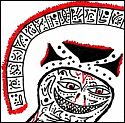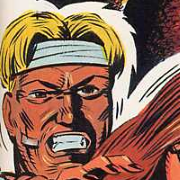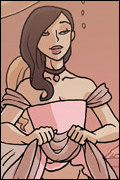|
Some cool archaeology in Copenhagen in the last couple years due to Metro construction & such. Generally accepted history has for centuries been that archbishop Absalon (~1128–1201) was granted Copenhagen by Valdemar I, and that it at the time was a small fishing village. Absalon built a fortress in 1167, and the church St. Clemens in 1177. The major written source to this is the Gesta Danorum (Deeds of the Danes), written by Absalon's secretary Saxo Grammaticus. However, it turns out that there were two earlier churches, both constructed in the 11th century (one located near the later St. Clemens). There also seems to have been a fortified building near the latter church. The former church appears to have been abandoned in the 12th century. This points to the "village" actually being a major city at the time, possibly "ruled" by two competing lords, each with their own church.
|
|
|
|

|
| # ? May 28, 2024 04:09 |
|
Milo and POTUS posted:If you're wondering how a character that was punished by death for refusing to reveal where fellow slaves ran away to became synonymous with being a quisling, this is it. AskHistorians had a good thread about this recently.
|
|
|
|
Carthag Tuek posted:Some cool archaeology in Copenhagen in the last couple years due to Metro construction & such. No it doesn't?
|
|
|
|
3D Megadoodoo posted:No it doesn't? Danish villages don't have multiple churches, that's only chartered cities (idk the word, købstæder) and the capital Also the speculation was straight from whoever archaeologist they interviewed
|
|
|
|
Carthag Tuek posted:Danish villages don't have multiple churches Curious theory seeing as how evidence to the contrary has just been posted.
|
|
|
|
3D Megadoodoo posted:Curious theory seeing as how evidence to the contrary has just been posted. 
|
|
|
|
Carthag Tuek posted:Some cool archaeology in Copenhagen in the last couple years due to Metro construction & such. I love local archaeology like this!  Anyway, I just found this and wanted to share:  (e: oh yeah, fair warning: the following text describes plenty of nasty poo poo including murder, suffocation, racism and rape)
I think one more small Austrian town should be added, namely Braunau am Inn (pop. 17,228) – not for a disaster or crime that occurred here, but for its most notorious inhabitant who would go on to easily win the title of “history’s most evil man”. He actually remained an honorary citizen of Braunau until 2011, when people realised that his name was actually still in the books and quickly moved to erase him from the list. System Metternich has a new favorite as of 08:36 on May 8, 2020 |
|
|
|
System Metternich posted:I think one more small Austrian town should be added, namely Braunau am Inn (pop. 17,228) – not for a disaster or crime that occurred here, but for its most notorious inhabitant who would go on to easily win the title of “history’s most evil man”. He actually remained an honorary citizen of Braunau until 2011, when people realised that his name was actually still in the books and quickly moved to erase him from the list. Imagine being the one that discovered that little tidbit in the town's documents and getting to drop that bomb at the next town council meeting.
|
|
|
|
Proteus Jones posted:Imagine being the one that discovered that little tidbit in the town's documents and getting to drop that bomb at the next town council meeting. That happened in lots of German and Austrian towns, mostly because people either assumed that an honorary citizenship would expire after death (turns out it's still a really bad look) or because they plain forgot/wanted to forget
|
|
|
|
That one about St Stefan sounds like the setup for a Slasher film
|
|
|
|
System Metternich posted:small town local murdercrimes That was not something I expected from this thread at all, I usually assume this thread is going to be about 500+ year old events and persons. Maybe someone from from 3000BC with a quip or hot take that is straight out of modern social media. It was a great read though! It reminded me a lot of the weird local history things here in upstate New York that I have run into over the years. On the route to my favorite camping area you go by the house where some guy had a bunch of imprisoned ladies in his backyard bunker until he got caught. There's Split Rock Quarry, that was a mining operation in the 1800s, became a munitions plant during World War I, something exploded and a lot of people died and they closed it down. You can hike through the rusted building posts and rock face they had been mining prior to WWI. It's creepy as heck. I really love this thread and the content it produces. Maybe sometime soon I'll spend a few hours making an effort post like yours, to share the weird loving poo poo that has happened in my backyard. We didn't make A Hitler, but I assure you the rest of it is just as weird as your post.
|
|
|
|
The longest-living person to rule England, before Elizabeth II surpassed them, was Oliver Cromwell's son, who died at age 85. Only ruled for less than a year though.
|
|
|
|
Less than a year?! What's the pension plan like
|
|
|
|
Carthag Tuek posted:Less than a year?! What's the pension plan like Not great if your last name is Cromwell.
|
|
|
|
Nth Doctor posted:Not great if your last name is Cromwell. I still get a laugh when I think of them digging up his corpse and hanging it posthumously
|
|
|
|
Cacafuego posted:I still get a laugh when I think of them digging up his corpse and hanging it posthumously It’s up there with Pope Formosus being put on trial nearly a year after he died.
|
|
|
|
Stephen VI’s argument was a masterstroke. Formosus was charged with transferring to a new ecclesiastical province—the pope is the bishop of Rome, so any bishop elected to the papacy is technically guilty of it. We got him! But wait! Isn’t Stephen himself guilty of the same move? We’ve got a solution to that. Who made Stephen a bishop? None other than the late Pope Formosus. With his acts now null & void, Stephen was never a bishop thus didn’t bold a bishopric. Rome was legally his first. No transfer.
|
|
|
|
Jesuitical sophistry wins again! Though you can't be transferred around as a bishop? How does that entire chain of command work?
|
|
|
|
|
Nessus posted:Jesuitical sophistry wins again! Though you can't be transferred around as a bishop? How does that entire chain of command work? The Cadaver synod was almost seven centuries before the invention of Jesuits, btw  The ban on bishops changing sees wasn't an absolute one; St Peter as the very first pope has done so himself, after all, when he first was bishop of Antioch before becoming bishop of Rome (by Roman tradition, at least). It was just that the First Council of Nicaea only allowed for a bishop to change sees in cases of absolute necessity or utility, but not if it only served the personal ambitions of the bishop in question which was exactly the charge laid against Formosus. The thought behind Nicaea back in the 4th century, so during a time that was very different from Formosus' and Stephen's time, was that clergy was supposed to be highly localised and urbanised, with not only bishops but also priests and deacons being supposed to stay and keep serving where they were - back then, bishops were mostly elected by the local community. This rule had mostly gone away by the 9th century, but some remnants of it still applied or were at least remembered. The ban on bishops changing sees wasn't an absolute one; St Peter as the very first pope has done so himself, after all, when he first was bishop of Antioch before becoming bishop of Rome (by Roman tradition, at least). It was just that the First Council of Nicaea only allowed for a bishop to change sees in cases of absolute necessity or utility, but not if it only served the personal ambitions of the bishop in question which was exactly the charge laid against Formosus. The thought behind Nicaea back in the 4th century, so during a time that was very different from Formosus' and Stephen's time, was that clergy was supposed to be highly localised and urbanised, with not only bishops but also priests and deacons being supposed to stay and keep serving where they were - back then, bishops were mostly elected by the local community. This rule had mostly gone away by the 9th century, but some remnants of it still applied or were at least remembered.
|
|
|
|
3D Megadoodoo posted:The longest-living person to rule England, before Elizabeth II surpassed them, was Oliver Cromwell's son, who died at age 85. You didn't even mention that he was commonly known as "Tumbledown Dick" because he was such a colossal gently caress up
|
|
|
|
There’s also the oft-recounted story that after he had fled to continental Europe to live in obscurity, he paid visit to the Prince of Conti as an English gentleman. The prince got to talking with him about the political situation in England, and said “Well, that Oliver, though he was a traitor and a villain, was a brave man, had great parts, great courage, and was worthy to command; but that Richard, that coxcomb, coquin, poltroon, was surely the basest fellow alive; what is become of that fool? How is it possible that he should be such a sot?” Some accounts say that he went “oh poo poo” and quietly left the city the next day, others say that he answered “that he was betrayed by those he most trusted, and who had been most obliged by his father”.
|
|
|
|
Unless that brewery has a label for every President, they chose the wrong one. If booze was involved Washington would be a mile head of the rest. Guy was such a party machine he actually got Congress to pay for his alcohol purchases as President, which was like $2.5K in 1770's dollars.
|
|
|
|
Alkydere posted:Unless that brewery has a label for every President, they chose the wrong one. If booze was involved Washington would be a mile head of the rest. Guy was such a party machine he actually got Congress to pay for his alcohol purchases as President, which was like $2.5K in 1770's dollars. The faces are pretty accurate if you imagine Lincoln is about to punch Jeff Davis. Washington is aghast that this might be a political thing that rocks the boat, Jefferson sneers down goonishly at the idea of a commoner freeing slaves, Teddy doesn't really care what's going on he just sees a very large man about to gently caress somebody up and is like "hell yeah!"
|
|
|
|
Edgar Allen Ho posted:The faces are pretty accurate if you imagine Lincoln is about to punch Jeff Davis. Nah Teddy would be shoving Lincoln outta the way to get the first punch in. Dude loved to fight so much
|
|
|
|
Teddy would have leapfrogged Lincoln to punch Jeff Davis in the face because of his never ending shame that his own father didn't fight in the civil war.
|
|
|
|
Alkydere posted:Unless that brewery has a label for every President, they chose the wrong one. If booze was involved Washington would be a mile head of the rest. Guy was such a party machine he actually got Congress to pay for his alcohol purchases as President, which was like $2.5K in 1770's dollars. Jefferson was a cider fiend. He loved the cider apple cultivar “Taliaferro” (pronounced “TALL–ivver” quote:unquestionably the finest cyder we have ever known, and more like wine than any other liquor I have ever tasted which was not wine It’s the holy grail of apples. It’s possible that it survives, but no plant matching its description with consistent provenance has yet been identified. The one description we have of the appearance of the fruit suggests something like this: 
Platystemon has a new favorite as of 03:39 on May 18, 2020 |
|
|
|
Alkydere posted:Unless that brewery has a label for every President, they chose the wrong one. If booze was involved Washington would be a mile head of the rest. Guy was such a party machine he actually got Congress to pay for his alcohol purchases as President, which was like $2.5K in 1770's dollars. After the ratification of the constitution, the writers racked up a bar tab of: quote:
Dudes could drink like mad.
|
|
|
|
The Founding Fathers were booze hounds to a man. The Declaration of Independence itself was drafted by Jefferson in a tavern, and the lot of them probably didn't see a sober day until the War of Independence was over, after which the real drinking began:Modern Drunkard posted:If there is anything left to be said regarding George Washington and his presidency it’s this: while in office he spent over seven percent of his sizable income on alcohol. Apparently Benedict Arnold was not a fan of drinking. Figures. 
|
|
|
|
Alkydere posted:Unless that brewery has a label for every President, they chose the wrong one. If booze was involved Washington would be a mile head of the rest. Guy was such a party machine he actually got Congress to pay for his alcohol purchases as President, which was like $2.5K in 1770's dollars. You mean George Washington's face wasn't naturally red? 
|
|
|
|
I just learned that Renato Bialetti, the son of the inventor of the Moka Pot and the long-time CEO of the eponymous company, was buried in an urn shaped like... you guessed it, Not surprised they decided to cremate his body 
|
|
|
|
barbecue at the folks posted:I just learned that Renato Bialetti, the son of the inventor of the Moka Pot and the long-time CEO of the eponymous company, was buried in an urn shaped like... you guessed it,
|
|
|
|
https://www.youtube.com/watch?v=sp-27vp6xXk It’s the perfect pandemic hideaway. Well, that and the palaces on each end.
|
|
|
|
barbecue at the folks posted:I just learned that Renato Bialetti, the son of the inventor of the Moka Pot and the long-time CEO of the eponymous company, was buried in an urn shaped like... you guessed it, If this becomes a trend the funeral for the guy who invented the aeropress is going to be wild
|
|
|
|
Phy posted:If this becomes a trend the funeral for the guy who invented the aeropress is going to be wild One word: JuiceroTM
|
|
|
|
Blendtec
|
|
|
|
Phy posted:If this becomes a trend the funeral for the guy who invented the aeropress is going to be wild
|
|
|
|
Platystemon posted:Blendtec 
|
|
|
|
Platystemon posted:Blendtec Will it blend? That is the question. :Horrible crunching noises as the corpse is atomized: Don't breathe this!
|
|
|
|
hell yea turn my corpse into a souplike homogenate
|
|
|
|

|
| # ? May 28, 2024 04:09 |
|
Carthag Tuek posted:hell yea turn my corpse into a souplike homogenate In just 30 seconds!
|
|
|














































